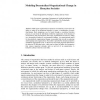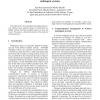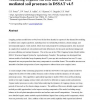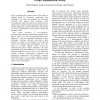289 search results - page 3 / 58 » A capabilities-based model for adaptive organizations |
ECAL
2007
Springer
13 years 11 months ago
2007
Springer
Multi-agent organizations in dynamic environments, need to have the ability to adapt to environmental changes to ensure a continuation of proper functioning. Such adaptations can b...
NECO
2000
13 years 5 months ago
2000
RF-LISSOM, a self-organizing model of laterally connected orientation maps in the primary visual cortex, was used to study the psychological phenomenon known as the tilt aftereffe...
IAT
2007
IEEE
13 years 11 months ago
2007
IEEE
This paper deals with a multiagent self-organization process aiming to give adaptive features to distributed embedded systems involving intelligent agents in open real world. We p...
OR
2010
Springer
13 years 3 months ago
2010
Springer
Cropping systems models have evolved over the last four decades in response to the demand for modeling to address more complex questions, including issues on sustainable productio...
SASO
2007
IEEE
13 years 11 months ago
2007
IEEE
Group communication primitives have broad utility as building blocks for distributed applications. The challenge is to create and maintain the distributed structures that support ...




